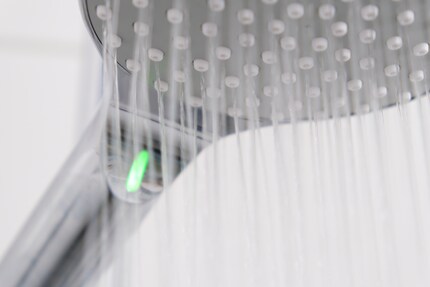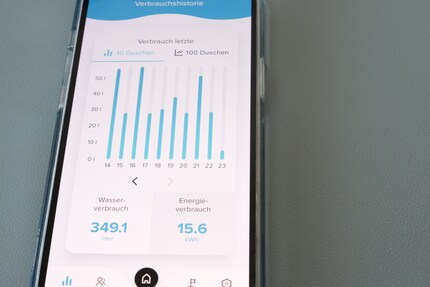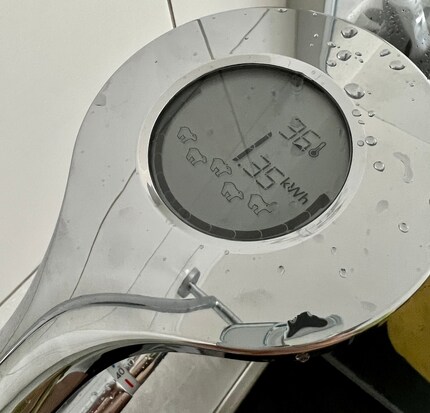

Review: the Amphiro hand shower converts longtime warm-water wimps
The economical, digital, handheld shower head provides live data on your water and energy consumption. The figures are compared to those of other Amphiro shower users. I’ve tested it to see whether an app and pictograms can turn me into a water saver.
This shower head can make polar bears disappear. Well, not directly. And not straight away. But if you shower with it for too long, five polar bear icons will gradually disappear from its display. You’re probably thinking: what is he on about? A shower head display? Polar bears? Excessively long showers?
Let me shed some light on the matter. Amphiro, a Swiss cleantech company, has a shower in its range that’s supposed to encourage you to use less water. It achieves this by way of a clever shower head and a corresponding app. I’ve tested it out for you to see if it works.

The installation and set-up go without a hitch
The «digital hand shower», as Amphiro calls it, has a half-inch thread, so it fits easily into the vast majority of shower hoses. In my case, I can simply unscrew my Hansgrohe shower head and replace it with the Amphiro one – even without using tools. The only thing I should’ve thought about is the residual water in the shower head. Great, now my socks are wet.
The hand shower is easy on the eye and has a high-end feel to it. It also shoots out 12 litres of water per minute at 3-bar water pressure – not too shabby. On the other hand, that’s hardly economical, is it? In fact, an energy rating of «A» is only granted when the flow rate is less than six litres.
The shower head has a diameter of 12 centimetres and allows for changes to the type of jet. That doesn’t actually cause me any issues because the stream flowing from the rubber studs is nice and soft, yet still powerful.
Despite having a display, the shower head doesn’t require any batteries. But it does require an app. I find mine in the App Store under «digital hand shower dhs» (it’s available in the App Store and on Google Play). Or I could use the QR code in the short instruction manual. After the download and inevitable registration process, the app guides me through the simple process of pairing my iPhone with the hand shower via Bluetooth.
This only works while the water is flowing – not exactly a flying start for an aspiring water conservationist. But technically speaking, there’s no other way of doing it. This is because the shower head contains a small turbine which generates the power necessary for the Bluetooth element. Swiss consumer issues TV show «Kassensturz» takes a peep inside the inner workings of the shower head in this video (just click the gear icon, «Subtitles CC» and «Auto translate» for English subtitles):
Room for improvement in the handling
Once paired with the app and smartphone, the hand shower displays how much water I use, what temperature I crank it up to and what that means for my energy consumption. I don’t need to log into the app before showering either. As soon as I turn on the shower, the usage stats are displayed on both the app screen and on the display on top of the hand shower. The shower head feels sturdy – it didn’t even break when I accidentally dropped it onto the floor of the shower.
There’s also an LED light on the bottom of the handle. Green at first, it then slowly turns yellow, before eventually – when I take a long shower – lighting up in red. That way, I can at least get a rough idea of how much energy and water I’m using without looking at the display on the top.

I’m in control of when the colour changes. I define my goal water consumption level – say, 40 litres per shower – in the app. Because of that, the shower head «knows» to change to yellow after about 20 to 25 litres, gently warning me that I should finish up. The LED lights up red once I’ve gone through about 35 litres.
The app records how much water and energy were consumed during each shower session. You’re then able to see the last 10 or even 100 showers as a bar chart or progression curve.
The transfer of data between the hand shower and the app doesn’t always work during my test. That’s despite always having my iPhone in the bathroom within the Bluetooth range of the «digital hand shower». Once I’ve finished showering, I can’t find the data that was displayed on the shower head in the app. The data from my second last shower, however, is entered correctly. There seems to be a delay.

Play your way to saving water
The basic idea of Amphiro is that you, the user, get transparent usage figures, can compare your shower habits to those of others and will want to change your behaviour for the better as a result. Basically, competition is the name of the game.
This works as long as you can see how «costly» every shower was – both for the climate and your wallet – on the display. Provided you have an idea of how much 1.5 kWh of electricity costs. And that if you shower daily, electricity costs alone quickly increase by 10 francs or more per month. It works because the app shows you how much your energy consumption and water use is in relation to that of the community and the most frugal 10 per cent.
But that’s it. The app is lacking some elements that’d give me, the user, a much stronger nudge towards changing my ways. If you ever use apps to learn languages or do exercise, you probably know what I mean. I, for example, get a daily push notification prompting me to do another French lesson so as not to lose my 131-day streak. Or I’m gently coaxed into doing a bit more exercise in order to close my exercise ring every day of the week.
In my opinion, it wouldn’t kill Amphiro and its algorithm to praise me once in a while – say, when I manage to use under 30 litres per shower for more than three days straight. Or maybe it could let me know when I’m just about to be welcomed into the Water Savers Hall of Fame. How about giving me a virtual polar bear rescuer award? The five onscreen polar bears gradually fading away is only of interest in the beginning. After a couple of weeks, I’ve practically forgotten about the feature.
It’d also be nice if different family members using the shower were able to organise a little water saving contest. This isn’t possible, however, because the hand shower doesn’t allow the set-up of individual user profiles.
Speaking of family, to record everyone’s shower stats separately, you need a break of at least three minutes between shower sessions. Only then can the app figure out that a new one is starting. What I actually always do is check that the display shows zero litres. If the break isn’t long enough, the system assumes that I’ve turned off the water briefly to soap up. Then it starts counting again.
Conclusion: economical and motivating
Before I set up the Amphiro shower head, I didn’t know how much water I was using. Thanks to the Amphiro, I’m all clued up. And that brings me to how much less time I spend in the shower. My sense of ambition aroused, I set a goal of 30 litres. And not too hot, as that guzzles more energy. Who needs warm water anyway?

If I manage that, and my family follows suit, we could save a couple hundred kilowatt hours in energy per year. A 2017 study (available in German) conducted by the University of Bamberg and the ETH Zurich has confirmed the effect in a scientific setting, too. So, even if you’re unconvinced that the consequences of the climate crisis can be minimised by taking shorter showers, investing in an Amphiro model can quickly pay off financially. With prices of 25 rappen per kilowatt hour, you’d recoup the cost of the shower after just a year if you saved 500 kilowatt hours. Which, according to the study, is doable.
I’m impressed by the design and quality of the hand shower. Personally, I’d like to have seen a gamification element in the app. But perhaps you’d be happy just to have your showering habits measured for variety’s sake.
Even if it isn’t possible to chart the consumption of individual household members, anyone and everyone with a smartphone can, in fact, look at the screen see and exactly how economical their shower was. It uses a carrot and stick approach. That way, the clever shower head is the perfect tool to discipline your perpetually showering teenagers. Maybe you could link the amount of pocket money they get to the survival rate of the polar bears on the display.
Although, the scientific study showed that people aren’t that bothered about polar bears. [It made no difference]((https://www.spiegel.de/wissenschaft/technik/energie-sparen-wie-wir-alle-beim-duschen-sparen-koennen-a-1239593.html) to the impact on water savings if the bear on the display was on land, on just a floating chunk of ice or completely underwater.
Still have questions about the hand shower? Or do you have tips for the Community on how to save water during a shower session? Let us know in the comments.
Journalist since 1997. Stopovers in Franconia (or the Franken region), Lake Constance, Obwalden, Nidwalden and Zurich. Father since 2014. Expert in editorial organisation and motivation. Focus on sustainability, home office tools, beautiful things for the home, creative toys and sports equipment.



